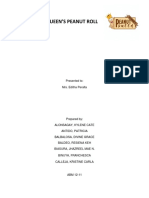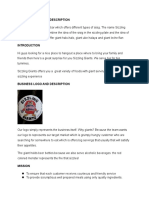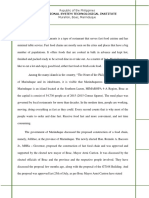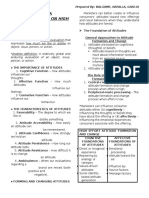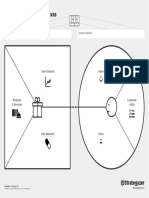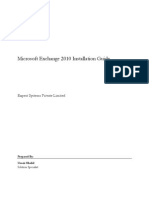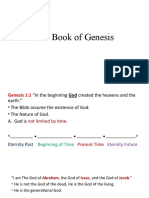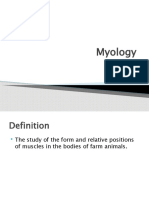Problem Recognition and Information Search
Problem Recognition and Information Search
Uploaded by
Alek Jethro BarciaCopyright:
Available Formats
Problem Recognition and Information Search
Problem Recognition and Information Search
Uploaded by
Alek Jethro BarciaOriginal Description:
Copyright
Available Formats
Share this document
Did you find this document useful?
Is this content inappropriate?
Copyright:
Available Formats
Problem Recognition and Information Search
Problem Recognition and Information Search
Uploaded by
Alek Jethro BarciaCopyright:
Available Formats
Chapter 7 Problem Recognition and Information
Search
Internal search- The process of recalling stored
information from memory.
External Search - the process of collecting
information from outside sources such as magazine,
dealers, advertisement, etc.
2 Forms of External Search
What kind of information is retrieved from
Internal search?
1. Prepurchase Search - occurs in response to the
activation of problem recognition.
>Brands >Attributes >Evaluations >Experience
2. Ongoing Search - consumers go on with their
research for a particular period of time if they decide or
if they want to buy a particular product. On going
activities basically show the work in progress.
Recall of Brands
Consideration (or evoked set)- The subject of topof-mind brands evaluated when making a choice.
Factors that increase the possibility of
consumers recalling a particular brand
Prototypicality-Consumers easily recall brands that
are closest to the prototype or that most resemble
other category members.
Brand Familiarity Well- known brands are more
easily recalled during internal search than unfamiliar
brands because the memory links associated with
these brands tend to be stronger.
Brand Preference-Brands toward which the consumer
has positive attitudes tend to be recalled more easily.
Retrieval Cues- are stimuli that assist in memory
retrieval. The presence of retrieval issues can make
recalling memories much easier.
Recall of Attributes
Factors influencing the recall of attribute
information
Accessibility/availability- Information that is more
accessible or available
Diagnosticity- helps us distinguish object from
another.
Salient attribute- attribute that is top of mind or
more important.
Vividness- It is presented as concrete words, pictures
or instructions tom imagine or through word of mouth
communication.
Goals- The consumers goals will determine which
attribute is recalled from memory.
Recall of Evaluations
-Because our memory for specific details decays
rapidly over time, we find overall evaluations or
attitudes easier to remember than specific attribute
information.
Recall of Experiences
-internal search can involve the recall of experiences
from autobiographical memory in the form of specific
images and the effect associated with them.
5 Key Aspects of the External Search Process
1. The Source of Information
2 The Extent of the External Search
3. The Content of the External Search
4. Search Typologies
5.The Process or Order of the Search
I. The Source of Information
- Where can we search for information?
Information about a certain product or service varies
from different sources. Consumers might get it from
either of the following:
Retailer Search- visits or calls to stores and dealers
including the examining of package information or
pamphlets about the brand, consumers believe they
save time by going to stores that are clusters together.
Media and Social Media Search- information from
advertising, online ads, manufacturer sponsored
websites and forums nd other types of marketer
produced communication as well as from Facebook,
twitter, blogs, and other social media sources.
Interpersonal Search-.advice from friends,
relatives, neighbors, coworkers, and/or other
consumers,whether sought in person, by phone,
online, text message, or in other way.
Independent Search - contact with independent
sources of information such as books, non brand
sponsored websites like shopping.com, government
pamphlets or magazines.
Experiential Search- using product samples or
product service trials such as test drive for cars, and
experiencing the product online.
Internet Sources
Throught Internet, consumers can search mounds of
data online, locate any details needed to make
purchase decisions and buy. In fact, consumers can use
the internet to get information from all five of the
sources just mentioned.
Information Overload
Consumers today have access to so much
information that they can actually become overloaded.
An overload can lead to a decline in decision quality.
Despite potential overload, does decision quality
suffer when consumers desire more options?
- Some research indicates that choice overload can
occur in situations where the problem is complex and
the consumer has difficulty dealing with complexity.
- Other research suggests that increasing the number
of options does not generally reduce choice quality.
Thus, marketers should always be sensitive to the
amount of information presented in order tk ensure
that overload does not occur.
Simulations
Advances in technology and graphics have
dramatically improved the online experience. Website
developers can now stimulate the retail experience as
well as product trials by creating site that incorporate
special and interactive effects including audio, video,
zoom, panaromic views, streaming media, and the 3D
features.
Creating a virtual product experience has a positive
effect on consumer product knowledge and brand
attitude thereby reducing perceived risk , and
increasing purchase intention.
The Online Community
People with common interest related to products or
services go online to share ideas by using websites,
discussions forum, text chat, etc.
3 Types of Causal Factors in Processing
Information
A. Motivation to process information
As motivation to process information increases,
external search will be more extensive. There are six
factors that can increase the motivation to conduct an
external search, and these are the following:
1. Involvement and Perceived Risk
the relationship between the situational involvement
(a response for a particular situation ) , and enduring
involvement ( an ongoing response ).
2. Perceived costs and benefits resulting from
the search
External search activity is also greater when its
perceived benefits are high relative to its costs.
3. Nature of the Consideration Set
If consideration set contains a number of attractive
alternatives, consumers will be motivated to engage jn
external search to decide which alternative to select.
4. Relative Brand Uncertainty
When consumers are uncertain about which brand is
the best, they are more motivated to engage in
external search.
5. Attitudes toward the search
Some consumers like to search for information and
do so extensively. These consumers have positive
beliefs about values and benefits of their search.
Most common interactions focus on product
recommendations and how to use it advice.
There are two groups of Internet searchers:
II. The Extent of the External Search
Experienced Searchers- most enthusiastic and
heaviest users of the internet
How much do we engage in external search?
Examining how much information consumers acquire
prior to making a judgment or decision.
The degree of such search activity ud usually quite
limited even for purchases. With more consumers
shopping online, search activity is increasing because
online sources are very consistent.
Searching Goods and Experience Goods
distinguished.
When searching experience goods ( products that
can't be easily evaluated until after purchase and use)
consumers tend to dig into details and spend some
time on each web page.
When researching search goods ( products that can
be evaluated before purchase or use) consumers tend
to cast the net wider, searching more sites but
spending less time on each web page.
Moderate and Light Users- sees the internet as a
source of information only, and not a source of
entertainment or fun.
6. Level of Discrepancy of New Information
Whenever consumers encounter something new in
their environment, they will try to categorize it by
using their stored knowledge.
B. Ability to Process Information
Having the ability to process information includes
different variables that might affect the extent of
external information search. These are the following:
1. Consumer knowledge
Common sense suggests that expert consumers
search less because they already have more complex
knowledge stored in their memory.
There are two types of consumer knowledge, first is
the subjective knowledge which pertains to the
consumer's perception about what he or she knows
relative to what others know. Then the other one is the
the objective knowledge, the actual information
stored in memory that can be measured with a formal
knowledge test.
2. Cognitive Abilities
consumers with higher basic cognitive abilities, such
as high IQ, and the abilitt to integrate complex
information, not only are more likely to acquire more
information but are also able to process these
information in a more complex way.
3. Demographic Factors
Consumers with higher education tend to search more
than the less educated consumer. It is because the
former have atleast moderate level of knowledge and
better access of information sources.
C. Opportunity to Process Information
Four Situational factors affecting the search process
1. The amount of information - can vary greatly
depending on the number of brands in the market, the
attribute information about a brand, the number of
retail outlet, and the diverse sources of information
available.
2. Information format- sometimes information is
available from different sources, but consumers must
spend considerable effort to collect it.
3. Time availability - Consumers who have face no
time restrictions have more opportunity to search
information.
4. Number of items being chosen- when consumers
are making a decisio about multiple items, research
suggests that they will conduct a more extensive
research with less variability in search patterns.
Some marketers use QR codes in their various
marketing elements so that consumers can get more
information via cell phone.
Marketing with QR Codes
how many are repeat visitors and how many click to
the brands website.
Dont:
Let design overpower the code consumers should
be able to see and scan the QR code wherever its
placed
Post once and forget it change the content from
time to time to encourage repeat visitors and
provide additional information if and when
consumers search again
Link to content not valued by the audience reward
customers for taking the time to scan the code by
offering interesting
Miss the chance to extend the relationship invite
consumers who scan the code to subscribe to an enewsletter or like the brand on Facebook special
offers, product specifications, and more details
III. The Content of the External Search
What kind of Information Is Acquired in External
Search?
Brand Name Information brand name is the most
frequently type of information because it is the central
node around which other information can be organized
in memory.
Price Information price is often the focus of
consumer search because it tends to be diagnostic and
can be used to make inferences about other attributes
such as quality and value.
Information about other attributes consumers will
search depends on which attributes are salient and
diagnostic in the offering category. Consumers are
more likely to access information that Is relevant to
their goals.
4. Search Typologies
Is External Search Always Accurate?
- consumers can be just as biased in their search for
external information as they are during internal search.
In particular, consumers tend to search for external
information that confirms rather than contradicts their
overall belief.
Do:
Have a purpose what is the purpose of the QR
code
Explain what will happen Let consumers know why
they should scan the code
Plan for the small screen Whatever content you
offer, be sure it looks good shrunk to the size of a
phone screen
Monitor and evaluate QR code usage track how
much time they spend with the information. And
5. The Process or Order of the Search
How Do We Engage in External Search?
- External search follows a series of sequential steps
that can provide further insight into the consumers
decision. These steps include orientationgetting an
overview of the product display; evaluation
comparing options on key attributes; and verification
confirming the choice.
1.
Search Stages consumers access different sources
use different decisions criteria at different stages of the
search process. In the early stage, mass media and
marketer-related sources tend to be more influential,
whereas interpersonal sources are more critical when
the actual decision is made. They are more likely to
access information that is especially salient, diagnostic
and goal oriented. If they can recall those, they have
little need to search for it externally.
2.
Searching by Brand or Attribute
Two major types of processes:
Searching by brand in which consumers acquire all
the needed information on one brand before moving
on the next
Searching by attribute in which consumers
compare brands in terms of one attribute oat a
time, such as by price.
Consumer Reports rating charts, which provide
information about the top brands and best buys in
various product and categories in a simple format.
You might also like
- Reflection (CFE 102)Document2 pagesReflection (CFE 102)Lerie Jade BernardoNo ratings yet
- Genlyd Model For Noise AnnoyanceDocument121 pagesGenlyd Model For Noise AnnoyanceDGHS HRMNo ratings yet
- Internal AssessmentDocument34 pagesInternal AssessmentShermahal Daul100% (1)
- Entrepreneurial Behavior: Course MaterialsDocument16 pagesEntrepreneurial Behavior: Course MaterialsHanna Jane DuhaylungsodNo ratings yet
- 06 Reaction Paper - The Entrepreneur's Business PlanDocument2 pages06 Reaction Paper - The Entrepreneur's Business PlanKristoffer PangueNo ratings yet
- Filipino Traits CharacteristicsDocument26 pagesFilipino Traits CharacteristicsJay DexNo ratings yet
- Chapter 10Document48 pagesChapter 10firebirdshockwave100% (2)
- Chapter 2 Human Rights Vis A Vis State SovereigntyDocument29 pagesChapter 2 Human Rights Vis A Vis State SovereigntyFLORES, JOHN MARK P.No ratings yet
- Organizational BuyingDocument41 pagesOrganizational BuyingLilibeth CarlosNo ratings yet
- 69547314Document3 pages69547314Jasmin GabitaNo ratings yet
- Peanutroll MANUSCRIPTDocument24 pagesPeanutroll MANUSCRIPTJhazreel Biasura100% (1)
- Discipline or Infraction CasesDocument9 pagesDiscipline or Infraction CasesBeah RoblesNo ratings yet
- Worksheet 2Document1 pageWorksheet 2Angilyn LagaticNo ratings yet
- Chapter 11Document5 pagesChapter 11AnnaNo ratings yet
- Don Honorio Ventura State UniversityDocument27 pagesDon Honorio Ventura State UniversityAngelica Gentolia HipolitoNo ratings yet
- Chapter-4 Other Sources of CreditDocument10 pagesChapter-4 Other Sources of Creditbateloshang01No ratings yet
- Pure Viand Final Papers Siomai AdoboDocument44 pagesPure Viand Final Papers Siomai AdoboRhumzel Lei Valenzuela AdonisNo ratings yet
- Business Plan: DGSJ T-ShirtsDocument11 pagesBusiness Plan: DGSJ T-ShirtsShielaMaeCasilOperioNo ratings yet
- Reaction Paper ChristineDocument4 pagesReaction Paper ChristineOlivia NemirNo ratings yet
- Source of Ideas For Entrepreneurial VenturesDocument13 pagesSource of Ideas For Entrepreneurial VenturesKelvin Jay Sebastian SaplaNo ratings yet
- Ten Commandments of Computer EthicsDocument3 pagesTen Commandments of Computer EthicsBSIT3_IT116No ratings yet
- University of Guyana PaperDocument15 pagesUniversity of Guyana PaperAnnMirelNo ratings yet
- AcknowledgementDocument5 pagesAcknowledgementAnuradha MasurkarNo ratings yet
- Strategy and National DevelopmentDocument35 pagesStrategy and National DevelopmentelmarcomonalNo ratings yet
- Module 4 BSSW 2BDocument31 pagesModule 4 BSSW 2BJoseah Mae SaenzNo ratings yet
- NSTP 1Document16 pagesNSTP 1MIGRACHIELLE AMIGOSNo ratings yet
- Consumer Behavior Sace LadyDocument4 pagesConsumer Behavior Sace LadyJerome PachecoNo ratings yet
- Week 4 Katrina Sison 12 Humss 1 EntrepDocument7 pagesWeek 4 Katrina Sison 12 Humss 1 EntrepKatrinapaula SisonNo ratings yet
- Personal Collection EditedDocument12 pagesPersonal Collection Editedclarky andradaNo ratings yet
- Document 8Document3 pagesDocument 8Abdullah ghauriNo ratings yet
- Eastern Visayas State University Dulag Satellite Campus: Republic of The PhilippinesDocument17 pagesEastern Visayas State University Dulag Satellite Campus: Republic of The PhilippinesSUPPLYOFFICE EVSUBCNo ratings yet
- Place StrategyDocument1 pagePlace StrategyBianca Amor ViquieraNo ratings yet
- Cultural Trends Changing How Filipinos BehaveDocument6 pagesCultural Trends Changing How Filipinos BehaveIvan Fritz AltavanoNo ratings yet
- The Target Customers and The Main Value PropositionDocument1 pageThe Target Customers and The Main Value PropositionZia ZobelNo ratings yet
- Business Name and DescriptionDocument4 pagesBusiness Name and DescriptionpviñezaNo ratings yet
- Effects of Geographical Area To The Sales of Local Snackhouses in Liliw, LagunaDocument130 pagesEffects of Geographical Area To The Sales of Local Snackhouses in Liliw, LagunaAlgem BacardiNo ratings yet
- Week 2Document7 pagesWeek 2ZsazsaNo ratings yet
- Narrative Report FinishedDocument19 pagesNarrative Report Finishedjohnvhicsalcedo3No ratings yet
- Customers' Preference Among Fast Food Chain Establishment in Tacurong CityDocument33 pagesCustomers' Preference Among Fast Food Chain Establishment in Tacurong CityJaysan SacbibitNo ratings yet
- Technology Forces in BusinessDocument3 pagesTechnology Forces in BusinessTurling100% (1)
- The Professional Salesman's CreedDocument2 pagesThe Professional Salesman's CreedabmaboocnecieboycNo ratings yet
- Narrative ReportDocument6 pagesNarrative ReportMycz Doña100% (1)
- An Egg Vendor Broke All The Eggs That He Was Delivering To A Local StoreDocument4 pagesAn Egg Vendor Broke All The Eggs That He Was Delivering To A Local Storeized.coffee0123No ratings yet
- Granby Values I: Granby'S Philosophy, Vision, and MissionDocument6 pagesGranby Values I: Granby'S Philosophy, Vision, and Missionmichelle100% (1)
- The Town of GamayDocument4 pagesThe Town of GamayManuelito UyNo ratings yet
- Business Plan EntrepDocument14 pagesBusiness Plan EntrepKaren RegioNo ratings yet
- Villareal Irone A. Module 8Document2 pagesVillareal Irone A. Module 8Cynel JavierNo ratings yet
- NSTP1 Module 4 Citizenship ValuesDocument84 pagesNSTP1 Module 4 Citizenship ValuesKristel BelgicaNo ratings yet
- Entrep Business PlanDocument21 pagesEntrep Business PlanKelvin Macato OccidentalNo ratings yet
- ENTREP Marketing Mindset Market and Message BDocument37 pagesENTREP Marketing Mindset Market and Message BEdlyn Liwag100% (1)
- ARNISDocument6 pagesARNISJoe GerminaNo ratings yet
- Hugutan Mo Ang Puto Ko Snack Treats: A Business Plan To Be Presented To The Faculty of STI College TanayDocument4 pagesHugutan Mo Ang Puto Ko Snack Treats: A Business Plan To Be Presented To The Faculty of STI College TanayRica DomingoNo ratings yet
- Perception of The Custumer Toward To The Food Restaurant To Be Built in Boac MarinduqueDocument18 pagesPerception of The Custumer Toward To The Food Restaurant To Be Built in Boac MarinduqueIshigami SenkuNo ratings yet
- Volunteer Act of 2007 - Written ReportDocument6 pagesVolunteer Act of 2007 - Written ReportKent Lewis GornezNo ratings yet
- Waiver OjtDocument2 pagesWaiver OjtGuian Carla Gutierrez100% (1)
- Congressional Integrated High SchoolDocument16 pagesCongressional Integrated High SchoolJeanelle DenostaNo ratings yet
- Business Plan: Department of Education Nabua National High School Nabua Camarines Sur Senior High SchoolDocument6 pagesBusiness Plan: Department of Education Nabua National High School Nabua Camarines Sur Senior High Schoolchrislyn antonioNo ratings yet
- Lesson 4: Relationship Marketing: Customer Perceived ValueDocument5 pagesLesson 4: Relationship Marketing: Customer Perceived ValueELMSSNo ratings yet
- Meeting 12 - Consumer Decision Making Information SearchDocument32 pagesMeeting 12 - Consumer Decision Making Information SearchKHOIRUNNIDA YASMIN -No ratings yet
- Attitudes Based On High EffortDocument5 pagesAttitudes Based On High EffortAlek Jethro BarciaNo ratings yet
- René DescartesDocument8 pagesRené DescartesAlek Jethro BarciaNo ratings yet
- Mister Donut HistoryDocument2 pagesMister Donut HistoryAlek Jethro BarciaNo ratings yet
- The Value Proposition CanvasDocument1 pageThe Value Proposition CanvasAlek Jethro BarciaNo ratings yet
- Overfull MarketingDocument1 pageOverfull MarketingAlek Jethro BarciaNo ratings yet
- Figaro Coffee CompanyDocument4 pagesFigaro Coffee CompanyAlek Jethro Barcia0% (1)
- Airline Industry of The PhilippinesDocument5 pagesAirline Industry of The PhilippinesAlek Jethro Barcia100% (1)
- Positive Vs Normative EconomicsDocument1 pagePositive Vs Normative EconomicsAlek Jethro BarciaNo ratings yet
- tp33 c6Document259 pagestp33 c6el46No ratings yet
- Religions and Belief SystemsDocument23 pagesReligions and Belief SystemsSunshine GarsonNo ratings yet
- Garden of Eden by Tracy K. Smith - POETRY and PLACESDocument1 pageGarden of Eden by Tracy K. Smith - POETRY and PLACESmarie.piveteau28.02.09No ratings yet
- Exchange 2010 Installation ManualDocument15 pagesExchange 2010 Installation Manualumair_awan_6No ratings yet
- Open Charge Point Protocol SOAP 1.6, OCPP-S 1.6 SpecificationDocument14 pagesOpen Charge Point Protocol SOAP 1.6, OCPP-S 1.6 SpecificationAulia NaufalNo ratings yet
- AsbestosDocument10 pagesAsbestosRachid ZgrhNo ratings yet
- Materi Bahasa Inggris SDDocument36 pagesMateri Bahasa Inggris SDMelly Eliany SuhandiNo ratings yet
- The Book of GenesisDocument10 pagesThe Book of GenesisLauntNo ratings yet
- CV Vishal KambleDocument2 pagesCV Vishal KambleGuru GskNo ratings yet
- MYOLOGYDocument20 pagesMYOLOGYNatty ChikumbaNo ratings yet
- 3 02.03.2020 NCLT Court No - IiiDocument5 pages3 02.03.2020 NCLT Court No - IiiVbs ReddyNo ratings yet
- A Safety-Focused Vehicle Driving Strategy Towards Minimal Injury Severity in Imminent Collision ScenariosDocument4 pagesA Safety-Focused Vehicle Driving Strategy Towards Minimal Injury Severity in Imminent Collision ScenariosDeepsNo ratings yet
- A2 Physics P5 Complete NotesDocument33 pagesA2 Physics P5 Complete Notesismail.xaidiNo ratings yet
- Surgery Questions by DR - PawanDocument8 pagesSurgery Questions by DR - PawanPawan KandhariNo ratings yet
- 2012 BL HandbookDocument262 pages2012 BL HandbookMohiyulIslamNo ratings yet
- Exlon Hdpe CatalogDocument32 pagesExlon Hdpe Catalogcarlos burgosNo ratings yet
- GQ Ball Pen Industries LTDDocument10 pagesGQ Ball Pen Industries LTDKhaled Hasan KhanNo ratings yet
- Ebook Hafele Furniture Fittings CompactDocument32 pagesEbook Hafele Furniture Fittings CompactIkhsanul HakimNo ratings yet
- M.SC Food NutritionDocument44 pagesM.SC Food Nutritionasu reddyNo ratings yet
- Thomas Ligotti Interviewed (2011) + Jean Ferry TaleDocument9 pagesThomas Ligotti Interviewed (2011) + Jean Ferry TaleRyan RodeNo ratings yet
- Employee MotivationDocument37 pagesEmployee MotivationSelvi TNo ratings yet
- 8A - Listening Unit 10Document2 pages8A - Listening Unit 10thuyNo ratings yet
- Sow English Year 4 2024Document12 pagesSow English Year 4 2024CikSodiumNo ratings yet
- Lesson 6 Fundamentals of WritingDocument40 pagesLesson 6 Fundamentals of WritingCEDRICK NICOLAS CUGAS VALERANo ratings yet
- Research GateDocument33 pagesResearch GateMawla Atqiyya MuhdiarNo ratings yet
- Great Is The LordDocument3 pagesGreat Is The LordPetrus Artquestra SupusepaNo ratings yet
- ORACLE IVS BW Premier Maceió Vulnerabi Vuln ReportDocument25 pagesORACLE IVS BW Premier Maceió Vulnerabi Vuln ReportandersonNo ratings yet
- Module Two Wellness Plan 1Document4 pagesModule Two Wellness Plan 1s11883758No ratings yet
- Types of Rock Lesson ObjectivesDocument2 pagesTypes of Rock Lesson ObjectivesKring-kring GumanaNo ratings yet










